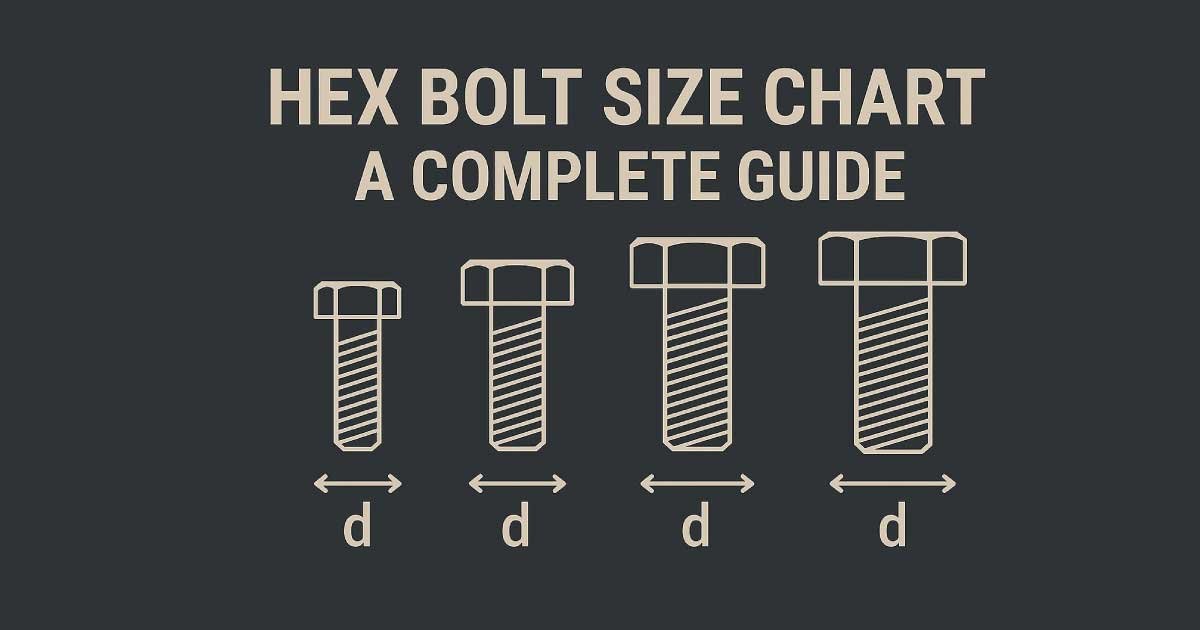Bolts may look simple, but they are critical for holding together everything from furniture to bridges. Among all types of bolts, the hex bolt is the most widely used. With its six-sided head, a hex bolt provides excellent grip for tools, allowing for high torque and secure fastening.
To select the correct bolt, you need to know its size. That’s where a hex bolt size chart comes in handy. In this guide, we’ll explain hex bolt dimensions, provide both metric and imperial size charts, and show you how to choose the right bolt for your project.
What is a Hex Bolt?
A hex bolt is a threaded fastener with a hexagonal head. It is tightened using a wrench or socket and is commonly paired with a nut and washer. Hex bolts are used in construction, automotive work, machinery, and countless DIY projects.
They are available in metric (M-sizes) and imperial (inch/SAE sizes).
Why Size Matters
Hex bolt size isn’t just about fitting into a hole. The correct size affects:
Strength: Larger diameters handle greater loads.
Fit: Bolt diameter must match the nut or threaded hole.
Tools: Each size requires a specific wrench or socket.
Safety: The wrong size can loosen, shear, or fail under stress.
Key Dimensions of a Hex Bolt
When reading hex bolt sizes, you’ll see something like M10 × 1.5 × 40 (metric) or 3/8″-16 × 2″ (imperial). Here’s what it means:
Diameter – Thickness of the bolt shank (M10 = 10 mm, 3/8″ = 0.375″).
Thread Pitch (metric) – Distance between thread peaks (M10 × 1.5 = 1.5 mm between threads).
Threads per Inch (imperial) – Number of threads per inch (3/8″-16 has 16 TPI).
Length – From under the head to the tip.
Head Size (Across Flats) – Wrench/socket size needed for tightening.
Metric Hex Bolt Size Chart
| Diameter | Thread Pitch (mm) | Wrench Size (Across Flats) | Common Uses |
|---|---|---|---|
| M6 | 1.0 | 10 mm | Furniture, appliances |
| M8 | 1.25 | 13 mm | Bicycles, automotive trim |
| M10 | 1.5 | 17 mm | Engines, machinery |
| M12 | 1.75 | 19 mm | Structural steel, heavy equipment |
| M16 | 2.0 | 24 mm | Construction frameworks |
| M20 | 2.5 | 30 mm | Industrial machinery |
| M24 | 3.0 | 36 mm | Bridges, steel structures |
Imperial Hex Bolt Size Chart (UNC – Coarse Threads)
| Diameter | Threads Per Inch | Wrench Size | Common Uses |
|---|---|---|---|
| 1/4″ | 20 TPI | 7/16″ | Furniture, light machinery |
| 5/16″ | 18 TPI | 1/2″ | Medium-duty projects |
| 3/8″ | 16 TPI | 9/16″ | Automotive, repairs |
| 1/2″ | 13 TPI | 3/4″ | Construction, machinery |
| 5/8″ | 11 TPI | 15/16″ | Structural work |
| 3/4″ | 10 TPI | 1-1/8″ | Heavy-duty use |
| 1″ | 8 TPI | 1-1/2″ | Bridges, industrial use |
Hex Bolt Grades and Strength
The grade shows how strong a bolt is. A larger diameter bolt isn’t automatically stronger—it also depends on grade.
Metric Grades: 4.6 (light duty), 8.8 (automotive use), 10.9 (high strength), 12.9 (very high strength).
Imperial Grades: Grade 2 (low strength), Grade 5 (medium strength), Grade 8 (high strength).
A M12 Grade 10.9 bolt can handle much more stress than a M12 Grade 4.6 bolt.
How to Measure a Hex Bolt
Measure diameter across the outer threads with a caliper.
Measure length from under the head to the tip.
Identify thread pitch (mm) or TPI (inch) with a thread gauge.
Check the head size across flats for the correct wrench.
Applications by Size
Small (M6–M8 / 1/4″–5/16″) – Furniture, bikes, small machinery.
Medium (M10–M12 / 3/8″–1/2″) – Cars, engines, general machinery.
Large (M16–M24 / 5/8″–1″) – Steel structures, heavy equipment.
Extra-Large (M30+ / 1-1/4″+) – Bridges, industrial construction.
Conversion: Metric ↔ Imperial
| Metric | Closest Imperial |
|---|---|
| M6 | ≈ 1/4″ |
| M8 | ≈ 5/16″ |
| M10 | ≈ 3/8″ |
| M12 | ≈ 1/2″ |
| M16 | ≈ 5/8″ |
| M20 | ≈ 3/4″ |
⚠️ Note: They are close but not interchangeable—thread types differ.
Practical Tips
Keep both metric and imperial charts handy.
Always confirm size with a caliper or gauge.
Don’t confuse diameter with head size.
Use washers to spread load and prevent damage.
Match bolt grade to the strength requirements.
Choosing the Right Material for Hex Bolts
While size and grade are crucial, the material of a hex bolt also plays a significant role in its performance and durability. Bolts are typically made from carbon steel, stainless steel, alloy steel, or even brass and titanium for specialized applications. Carbon steel bolts are strong and cost-effective, but they can rust if exposed to moisture. Stainless steel offers excellent corrosion resistance, making it ideal for outdoor or marine use. Alloy steel bolts provide high strength and are commonly used in automotive and machinery applications. Titanium bolts are lightweight and highly resistant to corrosion, but they come at a premium price and are often reserved for aerospace or racing applications. Choosing the right material ensures that your bolt not only fits correctly but also withstands the environmental and mechanical stresses of your project.
Understanding Bolt Coatings and Finishes
Hex bolts often come with various coatings or finishes to enhance performance and longevity. Zinc plating is common for mild corrosion resistance in indoor environments, while hot-dip galvanizing provides superior protection for outdoor and industrial use. Black oxide coatings improve aesthetics and provide moderate rust resistance, often used in machinery or automotive components. Some bolts are also coated with specialized chemicals for high-temperature or chemical-resistant environments. Selecting the correct coating can prevent premature failure and reduce maintenance needs.
Tips for Installation
Proper installation is just as important as choosing the correct bolt. Always use the right torque to avoid over-tightening, which can strip threads or break the bolt, and under-tightening, which can cause loosening under vibration. Using a washer can distribute the load more evenly and protect the surface of the material being fastened. For critical applications, consider thread-locking compounds to prevent bolts from loosening due to vibration.
Common Mistakes to Avoid
One of the most frequent mistakes is assuming that a bolt of the same diameter will automatically fit any application. Thread pitch, length, and head size must all match the requirements. Another common error is using a lower-grade bolt in a high-stress application, which can lead to catastrophic failure. Always double-check charts, measurements, and application requirements before fastening.
By understanding material types, finishes, proper installation, and common pitfalls, you can maximize the effectiveness and safety of your hex bolts, ensuring that each fastening is secure and reliable.
Conclusion
The hex bolt size chart is a must-have tool for mechanics, builders, and DIYers. By knowing the diameter, thread, and wrench size, you can confidently select the right bolt for any job.
From the small M6 bolts in furniture to massive M24 bolts holding steel structures together, hex bolts keep the modern world assembled. With this guide, you’ll always have the right size, strength, and fit for safe, reliable fastening.
Read our newest article here:

